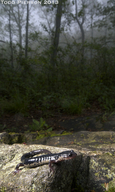|
Plethodon chattahoochee Highton, 1989
Chattahoochee Slimy Salamander Subgenus: Plethodon | family: Plethodontidae subfamily: Plethodontinae genus: Plethodon |
| Species Description: Highton, R., G. C. Maha, and L. R. Maxson. 1989. Biochemical evolution in the Slimy Salamanders of the Plethodon glutinosus complex in the eastern United States.. Illinois Biological Monographs 57: 1–153. | |
 © 2013 Todd Pierson (1 of 9) |
|
|
Country distribution from AmphibiaWeb's database: United States
U.S. state distribution from AmphibiaWeb's database: Georgia, North Carolina
Plethodon chattahoochee Highton, 1989 David A. Beamer1 1. Historical versus Current Distribution. Members of the P. glutinosus complex, Chattahoochee slimy salamanders (Plethodon chattahoochee) occur throughout much of the Chattahoochee National Forest in the Blue Ridge Physiographic Province of northern Georgia and southeastern Cherokee County, North Carolina. The type specimens were collected at an elevation of 1,353 m (Highton et al., 1989). There is no evidence to suggest that the current distribution differs from the historical distribution. 2. Historical versus Current Abundance. Highton (2003) reports a decline in the one Chattahoochee slimy salamander population he sampled, when comparing data from 1961–'84 with data from 1997, under similar sampling conditions and with a similar search effort. However, additional sampling must be done to determine whether this is the result of a true decline or a natural fluctuation. 3. Life History Features. Chattahoochee slimy salamanders were recently described (Highton, 1989). In this time, there has been no published work done on this species. As a portion of his larger research program, R. Highton has collected basic life history and natural history information on Chattahoochee slimy salamanders and has plans to publish these data in a monographic treatment. A. Breeding. Reproduction is terrestrial. i. Breeding migrations. Undocumented, but breeding migrations are not known for any Plethodon species. ii. Breeding habitat. Unknown. B. Eggs. i. Egg deposition sites. Unknown, but likely to be in underground cavities. ii. Clutch size. Unknown. C. Direct Development. i. Brood sites. Unknown. ii. Parental care. Unknown, but it is likely that females brood, as with other members of the slimy salamander complex. D. Juvenile Habitat. Unknown, but likely to be similar to adults. E. Adult Habitat. Has not been described. But, as with other Plethodon sp., forest floor habitats and cover objects are important. Animals are likely to be most active under moist conditions. Burrowing is likely to be important under inhospitable surface conditions. F. Home Range Size. Unknown, but small home ranges are typical for Plethodon species. G. Territories. At least some members of the Plethodon glutinosus complex aggressively defend territories (Thurow, 1976), but it is unknown whether Chattahoochee slimy salamanders establish and defend territories. H. Aestivation/Avoiding Dessication. Generally unknown, but Chattahoochee slimy salamanders likely avoid desiccating conditions by seeking shelter in underground sites. I. Seasonal Migrations. Animals likely make vertical migrations, moving from the forest floor to underground sites with the onset of seasonally related cold or dry conditions, then back up to the forest floor with the return of favorable surface conditions. J. Torpor (Hibernation). Generally unknown, but Chattahoochee slimy salamanders likely avoid cold conditions by seeking shelter in underground sites. K. Interspecific Associations/Exclusions. Chattahoochee slimy salamanders are parapatric with red-legged salamanders (P. shermani) near the Georgia–North Carolina border. A transect along the Tallulah River indicates that there is a wide hybrid zone (Highton and Peabody, 2000). Chattahoochee slimy salamanders contact southern Appalachian salamanders (P. teyahalee) in Clay County, North Carolina. A transect in the vicinity of Hayesville indicates that there is a narrow hybrid zone (Highton and Peabody, 2000). Atlantic Coast slimy salamanders (P. chlorobryonis) and Chattahoochee slimy salamanders contact in northeastern Georgia. A partially completed transect in White and Habersham counties has indicated that there is a parapatric hybrid zone (Highton and Peabody, 2000). Northern slimy salamanders (P. glutinosus) and Chattahoochee slimy salamanders contact at the western edge of the Blue Ridge Province in Georgia; there is no published information on their interactions (Highton and Peabody, 2000). L. Age/Size at Reproductive Maturity. Unknown. The holotype is a male, 62 mm SVL; the allotype a female 64 mm. M. Longevity. Unknown. N. Feeding Behavior. Unknown, but as with other Plethodon species, feeding likely takes place at night under moist conditions. Prey items likely include a range of invertebrates, especially insects. O. Predators. Undocumented, but likely to include forest snakes, birds, and small mammals. P. Anti-Predator Mechanisms. All Plethodon produce noxious skin secretions (Brodie, 1977). Members of the Plethodon glutinosus complex frequently become immobile when initially contacted. Chattahoochee slimy salamanders were included in a field study on immobility; however, it is not possible to separate their behavior from the other members of this complex in this published data set. Immobility may increase survival by making salamanders less likely to be detected, especially by visually oriented predators (Dodd, 1989). Q. Diseases. Unknown. R. Parasites. Unknown. 4. Conservation. Chattahoochee slimy salamanders are not listed in any of the states within their range. Among members of the P. glutinosus complex, Atlantic Coast slimy salamanders have one of the smaller distributions. Within this range, there are many federal and state properties that contain suitable habitat for these salamanders. As with all species of Plethodon, Chattahoochee slimy salamanders do not migrate to breeding grounds and they do not have large home ranges. Thus, they can exist in habitats of smaller size than many other amphibian species. Conservation activities that promote mature closed-canopy forests should benefit this species. Acknowledgments. Thanks to Richard Highton, who reviewed this account and gave us the benefit of his insight and experience. 1David A. Beamer 2Michael J. Lannoo Literature references for Amphibian Declines: The Conservation Status of United States Species, edited by Michael Lannoo, are here. Feedback or comments about this page.
Citation: AmphibiaWeb. 2024. <https://amphibiaweb.org> University of California, Berkeley, CA, USA. Accessed 19 Apr 2024. AmphibiaWeb's policy on data use. |



 Raffaëlli Account
Raffaëlli Account Map of Life
Map of Life